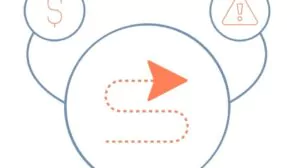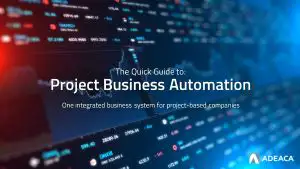Managing large, complex projects in disparate applications often results in projects delivered late and over budget. When project operations are managed in isolated tools and applications, the larger organization remains unaware of the operational state of projects. While the project plan is maintained in one system, the timeline is invisible to team members and other departments. That said, many potential issues get overlooked.
When it comes to project management, early detection is key. Detecting potential issues and risks early means the faster and more cost effectively you can respond. And the only way to mitigate project risk is through transparent and proactive project business management with a fully integrated scheduling system.
Project Scheduling in a Generation 3 Project Business System
As part of Adeaca PBA, the work breakdown structure (WBS) provides unique capabilities that go beyond other solutions on the market. Generation 1 and 2 systems today use the WBS as both the financial and operational hierarchy of the project which causes a major project governance flaw.
When the WBS is not integrated into the rest of your project processes and systems, it’s difficult to manage project workflow across multiple business dimensions. The fact is, without a truly integrated project business system, project data is disconnected. More specifically, any changes to the project schedule or timeline are often miscommunicated or not conveyed in a timely manner.
Due to the true integration of a generation 3 system, the WBS in Adeaca PBA eliminates the need for standalone project management applications and the overhead needed to manage them. The WBS is integrated into the rest of the project processes and systems.
The Project Timeline is Integrated with the Rest of Your Project Processes
The advantage of using a WBS as part of the project lifecycle management is that it takes large, complex projects and breaks them into smaller, more manageable tasks that can be assigned to specific people or teams to execute and deliver.
As a central component of Adeaca PBA, the WBS acts as the primary schedule against which all other activities and system operations are executed. This means the project timeline is managed inside the ERP, allowing connections between the schedule and timesheets, procurement and production, and costing and billing. This ensures schedule changes do not go unnoticed but rather align the entire organization and provides company-wide visibility and transparency.
- Leverage the project schedule to accurately build a labor budget, time-phase earned value estimates, and generate cash flow projections
- Apply the timeline directly to MRP for production orders, and automatically constrain the schedule based on procurement or production delays
- Staff projects more efficiently and automatically feed status updates, issues and work estimates back to the schedule from the timesheet
- Report on the financial impact of schedule changes immediately
Real-time Visibility and Control to Reduce the Risk of Schedule Disruptions
As part of a third-generation project business system, the WBS in Adeaca PBA is integrated with all other project data on one platform and provides real-time visibility into the status of your projects. This allows you to make better decisions based on accurate, timely data. In addition, any ancillary activities are based on the always current project plan. This reduces the risk of schedule disruptions and increases the likelihood that deadlines are met. This means project planners not only plan the project but provide the master timeline against which everyone else plans their activities.
To learn more about the Work Breakdown Structure in Adeaca PBA, download the Work Breakdown Structure Feature Brief.











